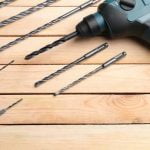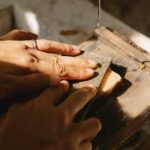Introduction
Using screws in woodworking offers a number of benefits. Not only do they provide a stronger connection than nails but they can also be removed and replaced more easily, making repairs or modifications simpler. Hiding the screws within the woodwork can also give a much cleaner finish to the project, allowing you to achieve professional looking results. This article will look at how to do this, as well as some tips and advice to help you get it right.
First, the type of screw should be selected based on the job being done and the material being used. Reamer-type screws are often best for hardwoods, while self-tapping screws work better in lower density woods such as softwoods or plywood. There are various magnetic or self-centring drill bits available which can help you drill straight holes for inserting your screws without accidentally splitting your stock.
Once all of your holes have been drilled, countersinks will need to be made using either a pre-made countersink bit, or by using a chisel if precision is required. This essentially means shaping the top of the hole so that the head of the screw sits below the surface level of your stock when it is inserted and tightened.
Finally, before inserting and tightening your screws make sure you use glue wherever necessary for additional strength, especially for joints where two pieces of material meet e.g corners and edges etc. This helps provide extra durability over time and helps keep every element secure against movement and vibration.
Types of Screws
There are several different types of screws used in woodworking. The most commonly used screws are Philips head, flathead, star drive, and square drive screws.
Philips head screws are designed for use with the Philips screwdriver – a common tool found in almost any home. These screws have a sharp point and an X-shaped head to provide extra gripping power which helps ensure that they stay securely in place.
Flathead screws have a flat top design that can be easily driven into wood surfaces with a flathead screwdriver or drill bit. They do not require pre-drilling into the material being fastened and provide good resistance against tampering or loosening over time.
Star drive screws are another popular choice for securing materials together in woodworking projects. These screws feature five pointed star shaped heads which provide superior gripping power when driving them into the material being fastened together. Unlike Philips head or flathead screws, star drive screws do not require pre-drilling and create tight fitting joints which resist tampering or becoming loose over time.
Finally, square drive screws are designed with four sides forming a hexagonal shape on their heads which help loops from slipping off during installation or removal. Square drive screws offer excellent gripping strength without the need for pre-drilling and create secure connections that will remain durable over time.
Prepping the Project
When it comes to hiding screws in woodwork, the first step is to determine what type of project you are working on. Do you need to build a bookcase from scratch? Are you refurbishing an existing piece of furniture? Knowing the size and structure of the project will help inform which type of screw is needed for the job.
Once you have determined your project’s scope, you can figure out what type of screws are ideal for attaching your pieces together. Choose a screw that won’t pull out easily should be a priority since this can compromise your final product. A self-tapping screw has a pointed scalp that bites into the wood and holds pieces firmly together while also installing in seconds with minimal effort. When selecting screws, ensure they are appropriate for the materials you are working with, such as wood or metal screws for wood projects, and always err on the side of caution when it comes to sizes and gauge based on your materials thickness and hardness.
Also consider where your screws will be located in relation to other fixtures, like doorknobs or drawer pulls that might get in the way. Pre-drilling holes along these lines can help guide screw placement and allow them to remain hidden from plain sight during construction or after when everything is completed. Additionally, use plugs or rosette pins to conceal screw heads once all pieces are attached securely.
Hiding the Screws
One of the best tools for hiding screws in woodwork is a pocket hole jig. This tool drills an angled hole that allows the screw to sit flush with the wood surface and remain virtually invisible. Making pocket holes usually involves drilling two appropriately sized holes, one perpendicular to the surface and one at an angle. Once the angle portion has been drilled, the screw can be inserted, resulting in a less pronounced screw head often with no visible hardware.
Other techniques for hiding screws include using plugs and dowels. These techniques involve drilling a small pilot hole from either side of the board then driving a plug or dowel into it to cover up any exposed hardware. A plug is made of hardwood while a dowel is essentially a wooden pin used to secure two objects together by being inserted into both pieces simultaneously.
Covering screws with traditional woodworking methods can also be effective in concealing them and creating an aesthetically pleasing finish on woodworking projects. This method involves countersinking them where possible and covering over the head with wood putty or other sealants that blend with the grain and coloration of existing woods. Finally, certain setups such as false joinery can also be used to hide screws while adding reinforcing strength to joints between rails and stiles in cabinet doors or drawers.
Specialty Screws
Using specialty screws for unique projects can be advantageous because they are designed to perform better than standard screws. Such screws often have more robust threads, sharper points, and more durable finishes. The extra strength in the threading makes them well suited for high-stress tasks such as load-bearing woodwork, furniture construction, and cabinetry installation. Specialty screws may also have non-corroding finishes which makes them suitable for outdoor use and other applications that may require extra protection from the weather or environment. Furthermore, the specific designs of certain types of specialty screws enable flush mount installations in wooden surfaces without exposed screw heads. This is a great benefit when pursuing an ultra-smooth aesthetic in your furniture or other projects requiring precision joinery work.
Tips and Tricks
1. Pre-drill: Before using a screw, pre-drilling a hole is key to achieving the best end result. It will prevent the wood from splitting and reduce the risk of cracking the woodwork.
2. Masking Tape: While pre-drilling use masking tape around the working area that way you can clearly see how deep you need to drill and minimize splintering when driving in screws.
3. Countersinking: When it comes to hiding screws, countersinking is essential for creating a flush finish – this means drilling down past the surface of your material until the screw head is almost level with it. This can be done either manually or (for greater accuracy) with an electric drill fitted with a countersink bit. Alternatively, you can use self-countersink screws to give them an extra level of security once they are set in place.
4. Spackle/Putty: For an extra measure of invisibility, putty or spackling compound can be used after countersinking and before painting/staining – this will close up any gaps around the screws so they are nearly impossible to detect under careful eyes!
Care and Maintenance
Hiding screws in woodwork is a great way to achieve a professional aesthetic and keep a room looking organized. Using appropriately sized screws also ensures that your project stays strong and avoids potential damage. To ensure optimal performance for the screws, it’s important to clean and lubricate them regularly. This can be done simply by using a steel brush or abrasive pad to remove any dirt and any metal shavings from drilling that may have attached themselves to the threads of the screw. It is important to ensure no dust or debris remains on the screw as this could interfere with its insertion into the wood. After cleaning, you should use a lubricant such as WD-40 to further protect the integrity of the screw. This will help allow it to drive easily through wood fibers without seizing up, bending or stripping away. Taking these steps will help extend the life of your screws and guarantee their efficiency for years to come.
Conclusion
When properly installed, screws play an essential role in woodworking projects. They provide much-needed reinforcements for joints and materials, ensure stability for furniture and other structures, simplify adjustments and changes, and can even be used to hide surfaces or components that would otherwise be visible. When using screws, it is important to carefully select the correct size and type of screw so that they sufficiently secure different components while maintaining a neat outward appearance. Hiding the screws within the woodwork also keeps the overall design of the project looking clean and professional. With careful installation techniques such as countersinking or predrilling, these hidden screws offer a wide range of benefits that make them preferable to any other fastening method.

Hi everyone! I’m a woodworker and blogger, and this is my woodworking blog. In my blog, I share tips and tricks for woodworkers of all skill levels, as well as project ideas that you can try yourself.





